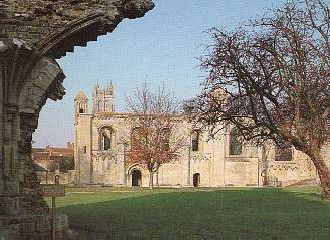 |
 |

Glastonbury Abbey
[Friday - 05/07/99] Glastonbury Abbey has long enjoyed the reputation of being the first Christian church in Britain, reputedly being founded as early as 37 AD by Joseph of Arimathea. Not until the eleventh century, however, do we hear anything of King Arthur and his knights emerging as historical personages, and still after, of King Arthur being buried in the choir of the great church, then re-buried by Edward I in 1278 at the high altar.
Long before the Saxons came to Britain, Christian missionaries built a little church of wattles in the district called Avalon. Whether that was in the second or third century or later, there is no way of telling. Not unnaturally the date was eventually put back to the first century. In the early seventh century As, the church was already old in the time of St. Paulinus, Archbishop of York, who had the church cased over with wood and lead.
In 601 AD, a grant was made by a King of Damnonia (the same word as Devon) of the land called Ynyswitrin to the ‘old church’, and an abbot, Worgret, is the head of the community. A hundred years later (700 or so), King Ina gives a charter and builds what was then considered a great church, to the east of the old one.
That the history of the earlier centuries should be filled in a little was natural. St. Patrick and St. Benignus, his disciple, are credited with having sojourned here in the fifth century. St. Bridget came, and lived at Beckery, another islet in the marsh. And in the sixth century, St. David (d.546) came and built an addition to the Old Church at the eastern end. The dimensions of the addition were very precisely set down by the chroniclers of the Abbey. Gildas, the historian, too, died and was buried here in 512. Of these statements (and there are more like them), the most credible is that about St. David. But all of them represent a truth: that Glastonbury was so sacred a resort in those centuries that the great lights of the Celtic Church would be likely visitors to it.
First, we hear that twelve disciples of the Apostles (the Apostle Philip is named) were sent from Gaul to Britain in AD 63. They came to Avalon, and king Arviragus and his successors granted them lands which came to be known as the Twelve Hides of Glastonbury. It was they who, at the bidding of the Archangel Gabriel, built the Old Church. The twelve died in course of time, and the place remained desolate until, in AD 166, King Lucius (first Christian king of Britain), by his missionaries Phagan and Deruvian, established another twelve, whose succession was not interrupted until St. Patrick, visiting the place in 433, set up a regular monastic life there.
The next great figure in the history of the Abbey is that of Dunstan, who was Abbot here (in 945 AD), repaired the ravages of the Danish invasion-period (about 870), and established a stricter mode of life. It is Dunstan who is figured in the central place on one side of the Abbey seal in the fourteenth(?) century (between St. Pattick and St. Benignus) and beneath him is a representation of that encounter of his with the devil, which nowadays is the first thing that springs to the memory when his name is mentioned. The tongs with which he pinched the devil’s nose were shown at the Abbey in the fifteenth century.
On May 29, 1184, a great fire consumed the whole place, including, the Old Church. It was rebuilt, in stone, and consecrated in 1186-7. This rebuilt chapel is the completest piece of the Abbey that remains. The great Abbey Church, dedicated to St. Peter and St. Paul, was begun about the same time. Extensive additions, modifications, and improvements filled successive centuries right up until the last Abbot but one, Richard Bere (1493-1524), including the start of a chapel to King Edgar (regarded as a saint at Glastonbury). The Edgar Chapel was finished by the last Abbot, Richard Whiting. His story is too sad to dwell upon. An old man of saintly life, a beneficent power in his countryside, he, rightly refusing to surrender his Abbey to the king, was executed on a trumped-up charge of embezzlement and treason on Glastonbury Tor, November 15, 1539.
At the Dissolution, it became the quarry of all the country round. Finally, in 1907, the site was purchased for the Church of England and placed under trustees.
The church was an enormous building. The total length, including the Lady Chapel on the west and the Edgar Chapel on the east, was some 590 feet. There only remains the shell of the Lady Chapel and Galilee, three bays of the south aisle wall of the nave; the eastem piers of the crossing; a bit of the north transept; a large portion of the south wall of the choir aisle; fragments of the east wall; besides foundations exposed by excavations. The only really intact building is the very pretty Abbot’s Kitchen which has an excellent exhibit inside.
|
Last modified on Wednesday, November 26, 2008 URL: http://www.housecorvus.org/abb.htm Copyright © 1999, 2000-09 House Corvus. All rights reserved. Design and hosting by Bran Trefonnen. | |